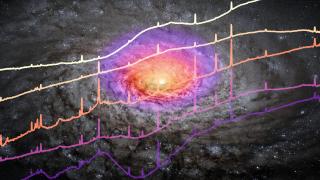Bibcode
de Sá-Freitas, Camila; Gadotti, Dimitri A.; Fragkoudi, Francesca; Coccato, Lodovico; Coelho, Paula; de Lorenzo-Cáceres, Adriana; Falcón-Barroso, Jesús; Kolcu, Tutku; Martín-Navarro, Ignacio; Mendez-Abreu, Jairo; Neumann, Justus; Blazquez, Patricia Sanchez; Querejeta, Miguel; van de Ven, Glenn
Bibliographical reference
Astronomy and Astrophysics
Advertised on:
10
2023
Journal
Citations
16
Refereed citations
15
Description
When galactic discs settle and become massive enough, they are able to form stellar bars. These non-axisymmetric structures induce shocks in the gas, causing it to flow to the centre where nuclear structures, such as nuclear discs and rings, are formed. Previous theoretical and observational studies have hinted at the co-evolution of bars and nuclear discs, suggesting that nuclear discs grow `inside-out' and thereby proposing that smaller discs reside in younger bars. Nevertheless, it remains unclear how the bar and the nuclear structures form and evolve over time. The smallest nuclear discs discovered to date tend to be larger than ∼200 pc, even though some theoretical studies have reported that when nuclear discs form, they can be much smaller. Using MUSE archival data, we report, for the first time, two extragalactic nuclear discs with radius measurements below 100 pc. Additionally, our estimations reveal the youngest bars found to date. We estimate that the bars in these galaxies formed 4.50−1.10+1.60(sys)−0.75+1.00(stat) and 0.7+2.60(sys)−0.05+0.05(stat) Gyr ago, for NGC 289 and NGC 1566, respectively. This suggests that at least some disc galaxies in the Local Universe may still be dynamically settling. By adding these results to previous findings in the literature, we are able to retrieve a stronger correlation between nuclear disc size and bar length. We also derive a tentative exponential growth scenario for nuclear discs.
Related projects

Traces of Galaxy Formation: Stellar populations, Dynamics and Morphology
We are a large, diverse, and very active research group aiming to provide a comprehensive picture for the formation of galaxies in the Universe. Rooted in detailed stellar population analysis, we are constantly exploring and developing new tools and ideas to understand how galaxies came to be what we now observe.
Anna
Ferré Mateu

Nuclear Activity in Galaxies: a 3D Perspective from the Nucleus to the Outskirts
This project consists of two main research lines. First, the study of quasar-driven outflows in luminous and nearby obscured active galactic nuclei (AGN) and the impact that they have on their massive host galaxies (AGN feedback). To do so, we have been granted time with the Gran Telescopio CANARIAS (GTC) in the optical and near-infrared ranges
Cristina
Ramos Almeida